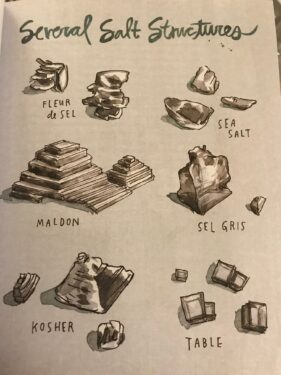We’re following up our last blog post that was a cookbook review of Samin Nosrat’s “Salt Fat Acid Heat: Mastering the Elements of Good Cooking” because the principle on salt was mind blowing (at least to me). Just so, so good. We’ll do three things with this blog post:
- Cover a few highlights from the chapter on salt from the book
- Update our previous post on “the perfect pot of pasta“, and
- Include a PSA reminder with a strategy to get enough iodine that includes salt!
Highlights from the chapter on Salt
Oh boy, where to start? I’ll share three highlights.
- First, salt is one of the most powerful flavour enhancers available to us. It has both its own flavour(s), and it brings out the flavours of other ingredients. As Nosrat writes, “Used properly, salt minimizes bitterness, balances out sweetness, and enhances aromas, heightening our experience of eating” (pg. 21).My aha moment here was the note on sweetness. When I’m baking mixed berry crumble bars, for example, I always throw a dash of salt into the crumble mixture towards the end. As I now know: it helps balance the sweetness of the berries!
- Second, salt enables seasoning food from within. This concept is bolded in the chapter. It’s the idea of adding salt at the right time, in the right amount, for the right food, to ensure it is seasoned properly at the bite, component, dish and meal level. For Nosrat, that’s the key to getting the most flavourful food. However, food should taste salted, and not salty (too much of it in there!).
- Third, know that there are lots of ways to add saltiness to food. From fish like anchovies or sardines, or capers stored in a brine. From fermented veggies like dill pickles, cornichons, krauts and kimchees. From fish sauce, soy sauce, or miso paste. Or cheeses, like feta! Cured meats like prosciutto, pancetta, or bacon. Seaweeds, olives, or salted butter. Use them wisely and carefully and they can really make your dishes zing! I’m quite fond of using capers for several of my own pasta dishes.
These are just my own highlights from the chapter. I won’t give everything away. I leave you with these notes to go explore the rest! (But for a few crumbs of what else is there: the chapter also includes a “salting calendar.” A whole chart on basic salting guidelines. Different methods to add salt (palmful, wrist wag and pinch). Tips on how to layer and balance salt. And more!)

The Perfect Pot of Pasta revisited
Given what we’ve learned about salt and how best to use it – it makes sense to revise our previous blog post on the perfect pot of pasta. In particular, Step 3 – adding salt to your pot! And of what kind.
Our first revision: use table salt. Have a box of regular table salt in your pantry for cooking purposes like this. It would be a waste to use any of the really nice Himalayan, Maldon or sea salt that costs much more per pound of salt. These fancier types of salt are best used at the table.
Our second revision: use more. I think trying at least half a tablespoon or even one, depending on how much pasta you are cooking, wouldn’t be misplaced in the pot.
I know… that seems like a lot! But. The pasta doesn’t cook long (5-10 minutes across our varieties), so the pasta won’t absorb that much of the salt. But what little it does absorb, will help bring out the flavour of the grains used in the pastas even more. You may want to try out different amounts and see what you find. By experimenting, you can find the amount that’s right for you.
PSA about salt and iodine!
It feels like the right time to be thinking about this topic. Mid-February, the CBC’s Senior Health Reporter Jennifer Yoon wrote about the almost 12% of Canadians that are in a growing group that aren’t getting enough iodine in their diet. The main reason? Changes in choices at the grocery store that include fewer people buying iodized table salt. Instead, folks are taking home Himalayan, sea, or Kosher salt – all of which do not contain iodine.
Iodine – in very small quantities – is quite important for our health. So much so that the federal government has long required that iodine is included in our table salt (since the late 1940s). That was (and is still) a safe, low-cost way to eliminate health issues caused by iodine deficiency: thyroid problems, cognitive issues including a drop in IQ, goiter, and prenatally, cretinism.
Going back to part 2 of this blog post, using iodized table salt to cook with our pasta can be an easy way to get a win win on this health priority.
A final comment – drinking dairy milk and eating a bit more seafood are also generally good ways, too.
Back to news


